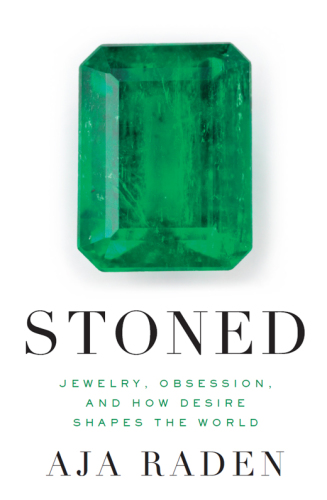
Stoned
Jewelry, Obsession, and How Desire Shapes the World
کتاب های مرتبط
- اطلاعات
- نقد و بررسی
- دیدگاه کاربران
نقد و بررسی

October 12, 2015
Jeweler and historian Raden discusses the intersection of desire, power, and economics through seven stories of some of the world’s most famous jewels. This journey through space and time takes readers through the purchase of Manhattan in 1626 from the Lenape natives by the Dutch for 24 dollars’ worth of glass beads, to the whole-cloth invention of the engagement ring “tradition” in the late 1940s by the diamond company De Beers. Along the way Raden shows how the importation of emeralds from South and Central America led the Spanish Empire to create the “world’s first interest-paying government bond,” in addition to setting the stage for colonialism. She also tells the story of how a diamond necklace, used as an emblem of Marie Antoinette’s corrupt excesses, helped spark the French Revolution. With these among other mini history lessons, Raden opens the discussion to a multitude of subjects including the psychology of desire and envy, the elemental makeup of diamonds, and the pearl-culturing process. Raden’s commentary on the often ugly side of human desire through the ages is consistently captivating, and her witty delivery makes the occasionally dry material shine. 16-page full-color photo insert.

October 15, 2015
Raden (senior designer, Tacori) examines just how integral jewelry and the desire for it were in influencing events throughout history. "The history of the world is the history of desire," posits the author. Tales such as the pearl that inspired Queen Elizabeth I to take on the Spanish Armada, the Faberge eggs that financed the Soviet Union, and the influence of Mikimoto's cultured pearls on bringing feudal Japan into modernity, provide strong support for this statement. A blend of history and science also foster thoughtful moments as Raden addresses the relativity of value and desire, particularly when discussing positional goods. While there are many other chronicles of jewelry, this one provides an unusual perspective by presenting jewelry as a key player in major historical developments. VERDICT History enthusiasts will be entertained by Raden's knowledge of famous names as well as her narrative approach to the topic. Occasional injections of humor will keep readers interested. [See "Editors' Fall Picks," LJ 9/1/15.]--Katie McGaha, Cty. of Los Angeles P.L.
Copyright 2015 Library Journal, LLC Used with permission.

September 15, 2015
A jewelry designer and historian's account of how the desire for diamonds, gold, and other precious stones and metals has shaped history. Raden begins with the premise that "all of human history can be boiled down to these three verbs: want, take, and have." The history of jewelry in particular demonstrates this idea with exceptional clarity. As the author demonstrates, human history is really a history of desire and the way that desire has motivated individuals to want, take, or have precious gems and metals, as well as the wealth or power that jewelry has traditionally represented. Raden first examines how gems and metals acquire their value by showing the way people throughout history have looked at certain commodities such as glass beads. The beads were worth little to early Dutch settlers in North America, but to the natives, they were priceless because they were unknown there. The author then delves into how obsession with objects of beauty-e.g., the diamond necklace Louis XV of France had made for his mistress Madame Du Barry-has been at the heart of some of the bloodiest, most violent historical events, including the French Revolution. At the same time, Raden also points out that this obsession has also led to "surprising developments in science and in economic and social infrastructure." She tells the story of the wristwatch, which started with a 19th-century Hungarian countess's desire to replace a large stone in a diamond bracelet with a tiny clock. Considered frivolous excess at first, the wristwatch gained popularity in the early 20th century when soldiers found that it could help with the precise timing required on modern battlefields. In this well-researched book, the author not only narrates the story of the human addiction to beauty and its consequences. She also reveals the way jewelry "reflect[s] our desires back to us and shows us who we are." A lively, incisive cultural and social history.
COPYRIGHT(2015) Kirkus Reviews, ALL RIGHTS RESERVED.

November 15, 2015
Oooh, shiny! Whether emeralds or diamonds, priceless pearls or timeless watches, jewelry has always had the power to fascinate and enslave. In its pursuit, wars have been waged and nations defeated, commoners beguiled and royalty beheaded. Revolutions have been fomented in the name of that which is rare and coveted. But why? What sort of artistic vision and skill transform an otherwise lackluster chunk of billion-year-old carbon into a luminous ring that symbolizes romance and fidelity? Weaving arcane history and spellbinding lore, Raden connects the dots between the unearthing of emeralds in South America and the unraveling of the Spanish empire; analyzes the ways consumers' emotions can be manipulated in the quest for status; and demonstrates how value is in the eyes of the beholder. A scientist, historian, and, most importantly, jeweler herself, Raden brings impeccable credentials to the task at hand. She also writes with a blithe and breezy deftness, peppering her narrative with snarky but substantive footnotes that recall the insouciance of Mary Roach. A gem of a study into all that enchants and bewitches.(Reprinted with permission of Booklist, copyright 2015, American Library Association.)

























دیدگاه کاربران